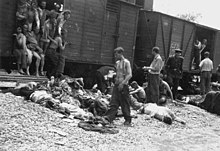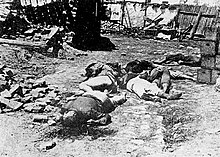The Holocaust in Romania was the development of the Holocaust in the Kingdom of Romania. Between 380,000 and 400,000 Jews died in Romanian-controlled areas, including Bessarabia, Bukovina and Transnistria.[1] Romania ranks first among Holocaust perpetrator countries other than Nazi Germany.[2][3][4]

Background
In the first decades of the 20th century, antisemitic views took the form of separation of Jews from European archetype[clarification needed] in publications and writings of prominent Romanian figures such as A.C. Cuza, Nichifor Crainic, Nicolae Iorga, Nicolae Paulescu and Ion Găvănescu.[5] The main political organisation that took these ideas and built them into an open attack on the Jewish community in Romania was the Iron Guard. Formerly a small political group under the name of Guard of National Conscience, the movement gained in its ranks in 1920 Corneliu Zelea Codreanu. Divisions and disagreements within the group and between members led Corneliu and others to leave and form the Legion of Archangel Michael in 1927, and then in 1930 the Iron Guard was created as an organisation to unite it with other nationalist groups. Despite renaming the organisation several times, in the media and public eyes the image and name of Legionaries and Iron Guard stuck for the anti-communist, antisemitic, fascist movement.[6]
Pre-war government policies and legislation

In Romania, antisemitic legislation was not an attempt to placate the Germans, but rather entirely home-grown, preceding German hegemony and Nazi Germany itself. The ascendance of Germany enabled Romania to disregard the minorities treaties that were imposed upon the country after the First World War. Antisemitic legislation in Romania was usually aimed at exploiting Jews rather than humiliating them as in Germany.[7]
At the end of 1937, the government of Octavian Goga came to power, Romania thus becoming the second overtly antisemitic state in Europe.[8][9] Romania was the second country in Europe after Germany to enact antisemitic legislation, and the only one besides Germany to do so before the 1938 Anschluss.[10][11] Romania was the only country other than Germany itself which "implemented all the steps of the destruction process, from definitions to killings."[12][13]
Anti-Jewish violence and deportations


The Romanian Holocaust was outside the control of the Nazis. Its beginning did not require Nazi intervention, Romania being the only ally of the Third Reich that carried out its genocidal campaign without the intervention of Heinrich Himmler's SS.[14] The "wholesale slaughter of Jews" in Romanian-occupied Soviet territories was "a genocide operationally separate from the Nazi Final Solution". It was by far the greatest extermination of Jews by non-German forces.[15] Romania also rejected Nazi designs on its Jews, ultimately declining to deport Romanian Jews to the Belzec concentration camp.[16] Romania even took the lead in the Holocaust for the first weeks of Operation Barbarossa. This was acknowledged by Adolf Hitler on 19 August 1941: "As far as the Jewish Question is concerned, it can now be stated with certainty that a man like Antonescu is pursuing much more radical policies in this area than we have so far." The regime of Ion Antonescu had been killing Jewish women and children, clearing entire Jewish communities, while Nazi Germany was still massacring only Jewish men.[17]
See also
References
